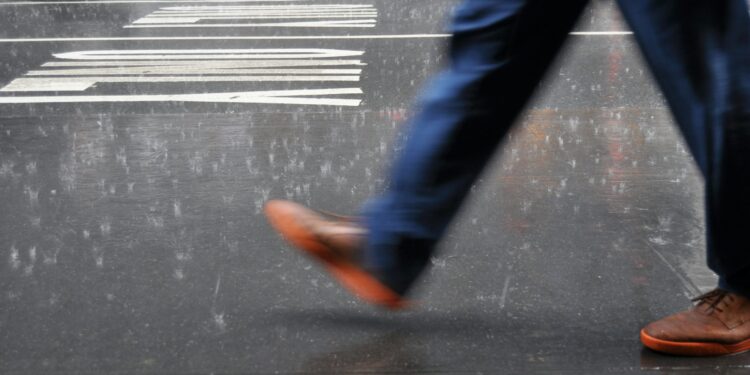Credit: Unsplash/CC0 Public domain
We’ve all been there, stuck outside without an umbrella as the skies open. Whether it’s a light drizzle or a heavy downpour, our instincts tell us that running will minimize our humidity levels. But is it really true? Let’s take a scientific look at this common dilemma.
You’re on the move and it starts to rain and you naturally forgot your umbrella. Instinctively, you lean forward and quicken your pace. We all tend to believe that going faster means we’ll spend less time getting wet, even if it means getting hit with more rain the further we go.
But is this instinct really correct? Can we build a simple model to find out if acceleration actually reduces humidity? More specifically, does the amount of water hitting you depend on your speed? And is there an ideal speed that minimizes the total amount of water you encounter on your way from point A to point B?
Let’s break it down while keeping the scenario simple. Imagine that the rain falls evenly and vertically. We can divide your body into two surfaces: those that are vertical (your stomach and back) and those that are horizontal (your head and shoulders).
When moving forward in the rain, vertical surfaces such as a person’s body will be hit by more raindrops as speed increases. From the walker’s perspective, the drops appear to fall at an angle, with a horizontal velocity equal to their own walking speed.
While walking faster means encountering more drops per second, it also reduces the time spent in the rain. Result: the two effects are balanced: more drops per unit of time, but overall less time in the rain.
When the walker is stationary, rain only falls on horizontal surfaces: the top of the head and the shoulders. When the walker begins to move, he receives raindrops that would have fallen in front, but misses the drops that now fall behind. This creates a balance and ultimately the amount of rain received on horizontal surfaces remains unchanged, regardless of walking speed.
However, because walking faster reduces the total time spent in the rain, the overall amount of water collected on horizontal surfaces will be less.
Overall, it’s a good idea to pick up the pace when walking in the rain
For those who like a mathematical approach, here is a breakdown:
To leave ρ represents the number of drops per unit volume, and either A designate their vertical speed. We will designate Ch as the horizontal surface of the individual (e.g. head and shoulders) and Sv like the vertical surface (e.g., the body).
When you are standing still, rain only falls on the horizontal surface, Ch. This is the amount of water you will receive on these areas.
Even if the rain falls vertically, from the perspective of a walker moving at high speed vit appears to fall obliquely, with the angle of the drops’ path depending on your speed.
During a period Ta drop of rain travels a distance of has. Therefore, all raindrops over a shorter distance will reach the surface: these are the drops inside a cylinder with a base of Ch and a height of haswhich gives:
ρ·Ch·A·T
As we have seen, as we move forward, the drops seem animated by an oblique speed which results from the composition of the speed A and speed v. The number of drops reaching Ch remains unchanged, since the speed v is horizontal and therefore parallel to Ch. However, the number of drops reaching the surface Sv-which was previously zero when the walker was stationary-has now increased. This is equal to the number of drops contained in a horizontal cylinder with a base area of Sv and a length of Vermont. This length represents the horizontal distance traveled by the drops during this time interval.
In total, the walker receives a number of drops given by the expression:
ρ(Ch·A + Sv·v)T
We must now take into account the time interval during which the walker is exposed to rain. If you travel a distance d at constant speed vthe time you spend walking is d/v. Incorporating this into the equation, the total amount of water you encounter is:
ρ(Ch·A + Sv2)·d/v = ρ(Ch·A/v + Sv)d
This equation gives us two key pieces of information:
- The faster you move, the less water hits our head and shoulders.
- The water hitting the vertical part of your body stays the same regardless of speed, because the shorter time spent in the rain is compensated by encountering more raindrops per second.
Bottom line: It’s a good idea to lean forward and move quickly when caught in the rain. But be careful: leaning forward increases Ch. To truly stay dry, you’ll need to increase your speed enough to compensate for this.
Provided by The Conversation
This article is republished from The Conversation under a Creative Commons license. Read the original article.
Quote: Walk or run in the rain? A physics-based approach to staying dry (or at least drier) (October 21, 2024) retrieved October 21, 2024 from
This document is subject to copyright. Apart from fair use for private study or research purposes, no part may be reproduced without written permission. The content is provided for informational purposes only.



